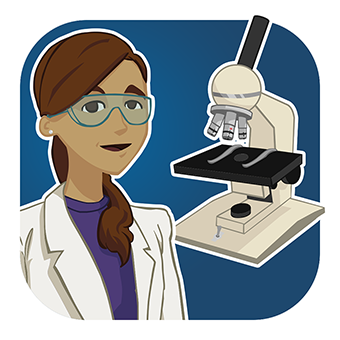VIRTUAL MICROSCOPE LAB EXERCISE
LEARNING OBJECTIVES
Identify and state the function of the parts of a compound brightfield microscope.
Properly focus a microscope.
Observe specimens using a compound brightfield microscope.
Explain how total magnification is calculated.
MCCCD OFFICIAL COURSE COMPETENCIES
Describe the structural characteristics of the major groups of microorganisms.
PHOTO REQUIREMENTS
Take a photo with your photo ID during the lab exercises when you see this icon.

Paste the photos in the Virtual Microscope Questions Document.
The microscope
Microorganisms are too small to see with an unaided eye and a microscope must be used to visualize them. Two major types of microscopes have been developed – the light microscope and the electron microscope. While light microscopes utilizes light waves from a light bulb, electron microscopes uses high energy electrons.
Magnification is the ability of the microscope to enlarge an object. Light microscopes have two magnifying lenses – the objective lens and the ocular (eyepiece) lens. The function of the ocular lens is to magnify an image ten times (10X). Most light microscopes have three objective lenses attached to a revolving nosepiece: the low power objective (10X), high-dry objective (40X), and oil immersion objective (100X).
As each objective is rotated into alignment, the specimen is magnified first by the objective lens and then the ocular lens. This magnified image is then transmitted to the human eye. Therefore, the total magnification of the specimen is calculated by multiplying the magnification of the objective lens times the magnification of the ocular lens. Total magnification = Ocular x Objective
virtual MICROSCOPE lab
You will use a virtual light microscope to view the Gram stained yogurt slides prepared in the Gram staining virtual lab.
1. Go to https://virtuallabs.nmsu.edu/micro.php
2. Below this image click Continue

3. Chapter 1 introduces you to the light microscope. Listen to the information and perform tasks described on each slide in chapter 1. Click continue after you listen to each slide in chapter 1. Find the answers to the following questions in chapter 1: What is the function of the following parts of a light microscope: stage clips, eye piece, diaphragm, coarse focus adjustment knob, fine focus adjustment knob? Write your answers in the Virtual Microscope Lab Questions Document.
4. Chapter 2 takes you through the steps of setting up the microscope. Listen to the information and perform tasks described on each slide in chapter 2. Click continue after you listen to each slide in chapter 2. Find the answer to the following question in chapter 2: How is total magnification calculated? Write your answers in the Virtual Microscope Lab Questions Document.
5. Chapter 3 takes you through the steps of focusing a slide on low power. Listen to the information and perform tasks described on each slide in chapter 3. Click continue after you listen to each slide in chapter 3. Find the answers to the following questions in chapter 3: When focusing do you begin with the coarse or fine focus adjustment knob? When viewing a sample, what objective lens do you start with? Write your answers in the Virtual Microscope Lab Questions Document.
6. Chapter 4 takes you through the steps of focusing a slide on high power. Listen to the information and perform tasks described on each slide in chapter 4. Click continue after you listen to each slide in chapter 4. Find the answer to the following question in chapter 4: What is the total magnification when viewing a specimen under high power? Write your answers in the Virtual Microscope Lab Questions Document.
7. Chapter 5 takes you through the steps of focusing a slide on oil immersion. Listen to the information and perform tasks described on each slide in chapter 5. Click continue after you listen to each slide in chapter 5. Find the answer to the following questions in chapter 5: What is the total magnification when viewing a specimen under oil immersion? Can you use the coarse focus adjustment knob when viewing a specimen under oil immersion? Write your answers in the Virtual Microscope Lab Questions Document.
8. Chapter 6 discusses how the contamination of the yogurt may have happened. Listen to the information on each slide in chapter 6. Click continue after you listen to each slide in chapter 6.
9. Chapter 7 takes you through the steps of clean up. Listen to the information and perform tasks described on each slide in chapter 7. Click continue after you listen to each slide in chapter 7. Find the answer to the following question in chapter 7: How do we sterilize a used slide? Write your answers in the Virtual Microscope Lab Questions Document.
10.  When you reach the end of the Using the Microscope virtual lab take a photo or screenshot of the slide at the end that states you have completed the Using the Microscope virtual lab. Paste the screenshot or photo into the Virtual Microscope Lab Questions Document.
When you reach the end of the Using the Microscope virtual lab take a photo or screenshot of the slide at the end that states you have completed the Using the Microscope virtual lab. Paste the screenshot or photo into the Virtual Microscope Lab Questions Document.

